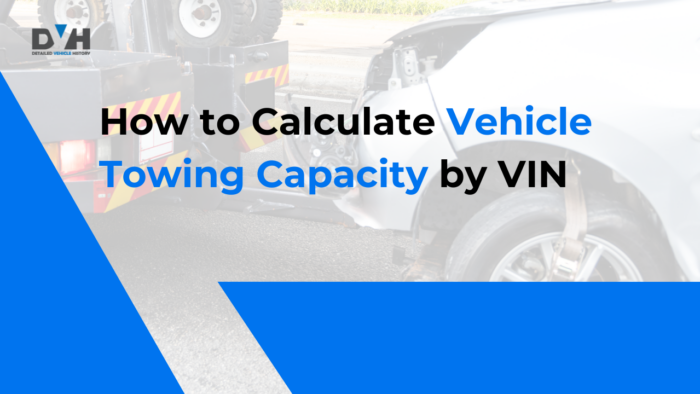Understanding your vehicle’s towing capacity is imperative in terms of its load-carrying ability in order to safely and efficiently transport goods. This knowledge assists in avoiding the chances of overloading and thus reducing the chances of mechanical failures or even accidents. Nevertheless, defining the exact towing capacity is not very easy, even though there are actual papers; it is especially valid for cars that are old or damaged.
This difficulty can make vehicle owners unsure and, in some cases, even endangered. To assist you with all these, this page seeks to offer all the information and sources that will enable you to determine the towing capacity of your particular car model, irrespective of the car’s age.
What Does Towing Capacity Mean?
The term “towing capacity” refers to the maximum weight a vehicle can safely tow. It’s usually stamped on the VIN plate, which is usually found beneath the bonnet, sometimes on the door pillar.
If you can’t locate your vehicle’s towing capacity around the body or in the places mentioned, try looking it up in your owner’s manual
Towing capacity comprises the weight of the trailer and everything it contains, including liquid fuel. You will agree with us that one cannot attempt cutting down a tree with a razor blade. Similarly, it will be foolhardy to attempt towing a load greater than the towing capacity of a particular vehicle.
It is, therefore, crucial to understand a vehicle’s towing capacity alongside other parameters, such as odometer readings (when buying a used car), to avoid overburdening the engine and transmission and compromising the entire structural integrity.
| Are you buying or selling a used car? Do you want to learn more about any car’s MSRP and other related built-in and added features of a vehicle, a window sticker lookup may be all you need to get such information. |
Also Read: What is MSRP: Everything you Need to Know
How to Find The Towing Capacity by VIN
There is no direct way to know your vehicle’s towing capacity using the VIN. However, the VIN can help you find the curb weight of your vehicle, which can be used to calculate the towing capacity.
You can use a VIN decoder to check your vehicle’s curb weight. To determine your vehicle’s towing capacity by VIN, you will need to use the VIN decoder option. VIN decoding is an absolutely free online tool that can be useful in determining or predicting the towing capacity of any vehicle.
Besides the towing capacity, the VIN decoder can offer information about aspects such as the general characteristics of the car, its transmission type, and even its engine. If you want to gain more information about some other component, this extra information helps, especially if they’re going to repair a vehicle after an accident.
It is now about time that we view some other facts and information that concern the towing vans.
How to Calculate the Towing Capacity
Understanding your vehicle’s towing capacity is crucial for safe and legal towing, as mentioned earlier. Let us define a few terms here before we continue:
- The Gross Vehicle Weight Rating (GVWR) indicates the maximum total weight that a vehicle can safely carry, including passengers, cargo, and the weight of the vehicle itself.
- The GCWR is the maximum allowable weight of a tow vehicle, trailer, and their combined load.
- The curb weight is the weight of your vehicle without any passengers, cargo, or accessories but with full fluids (oil, coolant, fuel, etc.). You can find your car’s curb weight on the owner’s manual or window sticker. If you lost those, you can get one from our window sticker lookup tool.
Let’s break down the calculation process into three steps:
Step 1: Determine Gross Combined Weight Rating (GCWR)
Gross Combined Weight Rating (GCWR) is the maximum allowable weight of a vehicle, including its own weight, passengers, cargo, and any attached trailer with its load. This rating is crucial for safety, ensuring that the vehicle’s engine, transmission, brakes, and suspension can handle the total weight without risk of failure. It’s important that you do not load weights more than the GCWR to avoid safety and mechanical issues.
Here’s the formula to calculate the GCWR:
GCWR = Weight of Tow Vehicle + Weight of Trailer + Weight of Cargo in Both Vehicle and Trailer
Step 2: Determining the Curb Weight
Curb weight is the total weight of a vehicle when it is not carrying any passengers or cargo, but with all standard equipment, necessary fluids, a full fuel tank, and no additional load. This measurement is essential for understanding the baseline weight of the vehicle, which helps determine towing capacity, payload limits, and overall vehicle performance.
Curb Weight = Weight of Empty Vehicle with Full Fluids
Step 3: Calculating the Towing Capacity
The last step in calculating the towing capacity is to utilize the simple formula, below is the formula for calculating the towing capacity. This simple formula could be utilized which is:
Towing Capacity = GCWR – Curb Weight
Let’s use this 2023 Ford F-150 as an example for this calculation.
- GCWR = 13,000 lbs
- Curb Weight = 4,021 lbs
- Towing Capacity = 13,000 lbs – 4,021 lbs = 8,979 lbs
In this example, this vehicle can tow at a maximum capacity of 8,979 pounds safely. Thereby, it is recommended to tow an object not exceeding about 8,000 pounds, which should be about or slightly lower than 90% to the vehicle’s towing capacity.
By observing the mentioned steps and incorporating the other factors, it becomes easy to know the towing capacities of your vehicle and exercise safe towing. Please refer to the specific mileage or distance settings of your automobile manufacturer owner’s manual for more details and constraints.
Conclusion
Thus, one can state that it is highly important to be aware of your vehicle’s towing capacity to ensure safe towing. With the help of our vehicle history report, you can identify your car’s characteristics and its hauling capacity in particular, knowing which is critical to avoid overload and harm to your car.
Determining how much you can tow includes some basics, such as the GCWR and curb weight. It means that in increasing the towing ability several parameters can be modified but must always be done within the manufacturer’s recommendation and that of a professional tuner.
Concerning handling, safety should come first, emphasizing correct loading and service and following the carrying vehicle’s capabilities. For any doubt or questions, one must consult a mechanic or the manufacturer of the vehicle in question. If you want to understand other specifications such as the transmission, etc., you should utilize the free VIN number lookup
Frequently Asked Questions
Ideally, you should never tow more than the maximum towing capacity. Doing so causes an intense load on the engine and transmission, which may lead to overheating and breakdown.
Braking with a heavier load than recommended also deteriorates the brake pad quicker, leading to more frequent replacement. Suspension blowouts are also a risk as a result of more weight. In short, there are critical safety concerns that may be caused by exceeding towing capacity.
It is recommended to limit the towing capabilities to 80-90 percent of their maximum. This buffer is necessary for offsetting of client deviations like shifts in loads as in a truck or more passengers than initially estimated.
There are several steps you can take to improve your vehicle’s towing capacity. The first one is to upgrade your suspension system to manage the extra weight. Next, you can also install a higher-rated hitch to ensure the car has a solid connection between your vehicle and the trailer.










